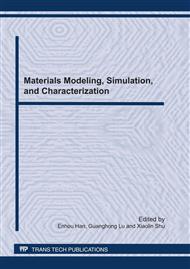p.179
p.184
p.190
p.198
p.204
p.211
p.220
p.226
p.235
Structural and Mechanical Properties of RT2Zn20 and RFe2-xCoxZn20(R=Y, Sm; T=Fe, Ru, Os, Co, Rh and Ir)
Abstract:
The phase stability, crystal structure and mechanical properties of YT2Zn20 and SmT2Zn20 (T=Fe, Ru, Os, Co, Rh and Ir) compounds have been investigated by using interatomic potentials based on the lattice inversion technique. The calculated lattice constants are in good agreement with the experimental data. The lattice constants increase and Bulk modulus decrease as the transition metal T varies from 3d to 5d. The Y-based compounds with lower energies are more stable than the Sm analogs. Also, the Bulk modulus of YT2Zn20 series are larger than SmT2Zn20 series. Moreover, the mechanical properties of the quaternary compounds YFe2-xCoxZn20 and SmFe2-xCoxZn20, such as the elastic constants and bulk modulus, have been calculated in this work. The substitution of Co atoms would decrease the cohesive energies and increase the bulk modulus of materials.
Info:
Periodical:
Pages:
204-210
Citation:
Online since:
June 2011
Authors:
Price:
Сopyright:
© 2011 Trans Tech Publications Ltd. All Rights Reserved
Share:
Citation:


